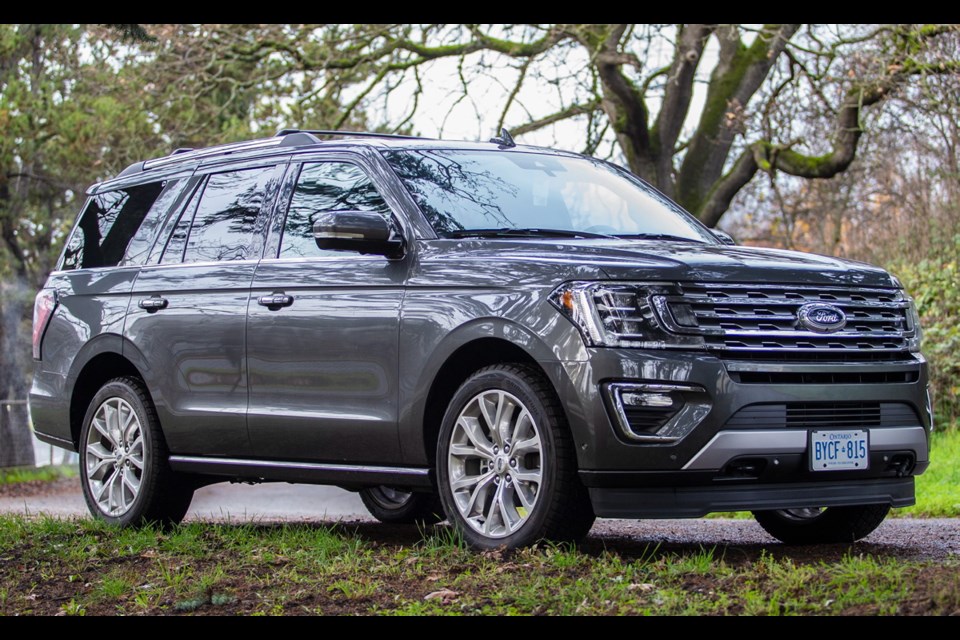In a clash of the titans, the 2018 Ford Expedition proves to be an worthy adversary in a market segment where bigger is better.
The Expedition fits into the full-size SUV niche market segment. Unlike many market segments, you can almost count the competitors in one hand — the GMC Yukon, Chevrolet Tahoe, Nissan Armada and Toyota Sequoia. (I consider luxury SUVs, such as the Mercedes Benz GLS, a separate segment.)
Need even more room? Extend the body length by 300 millimetres and the wheelbase by 230 mm to get the Expedition Max. Competitors in this segment shrink further to XL versions of the Yukon and Tahoe and the Chevy Suburban.
But today I drive the “smaller” Expedition, which starts at $59,999 for the XLT model. My tester is the Limited trim, which has a $72,999 price tag. The top-of-the-line Platinum, just in case you are wondering, costs a cool $80,999.
If you are considering the Expedition, you are typically interested in it because of two scenarios. One is the ability to carry eight occupants — and their gear — in comfort. The other is that you are planning to tow something substantial behind you.
In both scenarios, the Expedition is in its element. The interior is voluminous, with stretch-out room for second-row and third-row occupants.
Passengers in the rearmost seats can thank Ford for using an independent rear suspension instead of a live rear axle, which the General Motors twins use. The swap means a flatter floor and a lower load-floor height for the cargo compartment, which can hold a maximum of 2,962 litres (105 cubic feet).
The independent suspension also contributes to a more controlled ride.
Depending on the trim and options selected, you can get a three-seat second-row bench or two captain’s chairs, as found on my tester. The seats recline and have considerable fore and aft movement.
The needs of the driver are not forgotten. The 2018 Expedition — the fourth generation — is expectedly tech-savvy, with a bevy of technological advances, including the latest in connectivity, infotainment and safety. The driver can choose between multiple screens to display engine performance, towing information, entertainment (including a Wi-Fi hotspot that supports up to 10 devices) and passenger comfort.
If you have plans for a long-distance trip, the Expedition will get you, and up to seven members of your family or friends, to your destination comfortably.
My tester had a headrest DVD entertainment system for occupants in the second-row seats.
At the heart of the Expedition is a covered version of a F-150 truck, a vehicle with a steel chassis. To save weight, Ford has substituted aluminum for metal for most of the body panels.
To achieve best-in-class fuel economy, Ford has gone one step further, forgoing a traditional V-8 motor for a twin air-to-air intercooled turbocharged V-6 — the only such application in the segment.
Doing so drives down fuel consumption to 13.8 L/100km in the city and 10.7 on the highway, putting all of the Expedition’s competitors to shame.
More impressively, it manages to achieve its fuel consumption bragging rights without any loss of performance. Unlike cars, performance in trucks means the grit to haul: The turbocharged 3.5-litre six produces 375 horsepower and 470 pound-feet of torque, compared with 383 pound-feet of torque for the GM twins.
Need even more power? Order the Platinum and you get a bump to 400 hp and 480 lb.-ft. of torque.
Properly equipped, the Expedition Limited can haul a maximum of 4,173 kilograms (9,200 lbs.) with a standard 4x4 set-up. It boasts a power-to-weight ratio of 109.5 watts/ per kilogram.
Another unique selling point is Ford’s 10-speed automatic transmission, the only such application on the market (the GM twins and Toyota have to make do with six-speed autos).
The extra gears means not only better fuel economy and lower rpms, but the ability to better match engine load to a gear.
Some vehicles look out of proportion, due to their too-small wheels. No need to worry about it in the Expedition’s case. You get standard 20-inch 275/55 tires on the Limited already. If that is not enough, you can opt for even larger (and more low-profile) 285/45 R22 tires.
When you choose a full-size vehicle, you can expect it might present challenges in the city. The Expedition gives you an all-round camera as a parking aid. There is also an automatic parallel parking system to help you squeeze into any available spot.
Thanks to Ford adopting a number of innovative technologies, the Expedition stands out in the full-size SUV segment. It doesn’t leave anyone behind, rides quietly, hauls all your toys and does so as economically as possible. If it were a teddy bear, I would give it a big hug.
THE SPEC SHEET
Type: Full-size SUV, front-engine, 4x4
Engine: Twin-turbo 3.5-litre V-6, 375 hp at 5,000 r.p.m., 470 lb.-ft. of torque at 3,500 r.p.m.
Transmission: 10-speed automatic
Dimensions (mm): Length, 5,333; width, 2,130; height, 1,941; wheelbase, 3,112
Curb weight (kg): 2,551
Price (base/as tested): $72,999/ $84,394 (includes $1,790 freight and PDI and $100 AC tax)
Options: Equipment group 302A Driver Assistance Package $5,000, 2nd row captain chairs $400, all-weather liners $150, heavy-duty trailer tow $1400, cargo mat $55, headrest entertainment system $2,000, cargo management system $400
Tires: 285/45 R22 on alloy wheels
Fuel type: Regular/premium
Fuel economy (L/100km): 13.8 city/ 10.7 highway
Warranty: Three years/60,000 km new car, five years/100,000 km powertrain and roadside assistance



